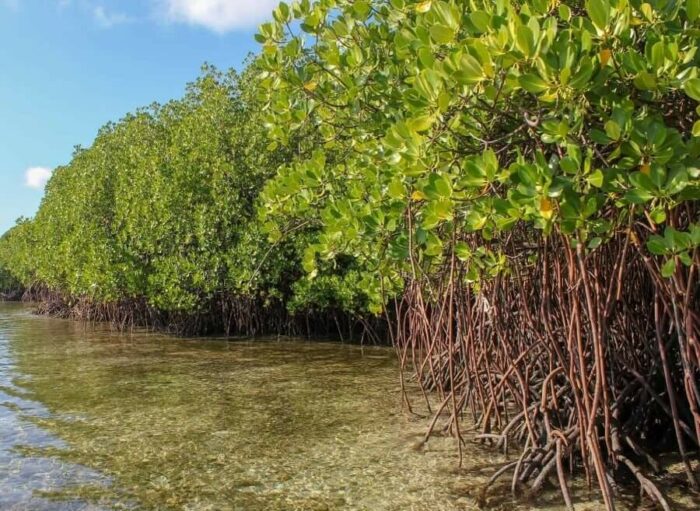Sea level rise is a term most Floridians are quite familiar with, as uncertainty grows regarding what the future may look like in this low-elevation state surrounded by the ocean.
How much is the sea level rising?
Since 1880, the global average sea level has risen between 8 and 9 inches, and studies show that this rate of rise is only accelerating. Increased greenhouse gas emissions, which trap warm air inside Earth’s atmosphere, have led to warmer oceans. Warmer water expands and physically takes up more space than cooler water, causing the sea level to rise. Global warming has also led to the melting of ice sheets in Antarctica and Greenland, causing these glaciers to release water into the ocean, further contributing to sea level rise.

What does sea level rise mean for Miami?
For coastal cities like Miami, Florida, which sits at an average of 6 feet above sea level, the accelerating rate of sea level rise has alarmed scientists. Not only are global sea levels rising, but Miami is also sinking, with some areas of Miami Beach experiencing subsidence at rates of 1-3 mm per year. These factors, combined with the fact that Miami is built on extremely porous limestone, have led to flooding and coastal erosion that will only worsen with time.
We know that sea level rise is accelerating, but what can we do to manage the impacts? South Florida coastlines were once covered in mangroves, salt-tolerant trees with complex root systems that protect coastlines by absorbing wave energy, decreasing the strength of waves before they crash on shore. Unfortunately, as Miami has urbanized to accommodate an influx of people and businesses, coastlines have changed dramatically, and in many areas, mangroves have been replaced with concrete seawalls. Seawalls have not only been proven to be less effective at coastal protection and more costly than the mangroves they have replaced, but they also fail to support the marine creatures that call mangrove ecosystems home. Many species of birds, fish, mammals, and amphibians rely on unique mangrove ecosystems for food and protection from predators, especially during the juvenile stage.
Sustainable Solutions
Miami-based company Kind Designs has found a solution to this dilemma: Living Seawalls. These 3D-printed concrete seawalls are shaped to resemble mangrove roots and offer 60% more surface area than a traditional concrete seawall. The irregular pattern of these Living Seawalls helps to dissipate wave energy while serving as an artificial reef for marine creatures to attach to. The colonization of these seawalls by marine invertebrates, plants, and fish can also reduce atmospheric CO2 levels through carbon sequestration. Despite their unique shape that encourages attachment by marine creatures, Kind Designs’ Living Seawalls are structurally identical to a traditional concrete seawall and can be used in any project.
As climate change progresses and sea level rise accelerates, Miami must adapt to protect itself from flooding, erosion, and eventual submergence. Living Seawalls are a testament to the importance of learning from Mother Nature in this endeavor.
References:
GregIacurci. (2024, April 26). Miami is “ground zero” for climate risk. people are moving to the area and building there anyway. CNBC.
How high will sea levels rise in Miami due to climate change? Miami Herald. (n.d.).
Lindsey, R. (2022, April 19). Climate change: Global sea level. NOAA Climate.gov.
Living Seawalls. KindDesigns. (n.d.). https://www.kinddesigns.com/products/living-seawalls/
Simone Fiaschi, Shimon Wdowinski,
Local land subsidence in Miami Beach (FL) and Norfolk (VA) and its contribution to flooding hazard in coastal communities along the U.S. Atlantic coast,
Ocean & Coastal Management, Volume 187, 2020, 105078, ISSN 0964-5691, https://doi.org/10.1016/j.ocecoaman.2019.105078. (https://www.sciencedirect.com/science/article/pii/S0964569119309470)
Weaver, Robert J., and Abigail L. Stehno. 2024. "Mangroves as Coastal Protection for Restoring Low-Energy Waterfront Property" Journal of Marine Science and Engineering 12, no. 3: 470. https://doi.org/10.3390/jmse12030470
Image sources:
Lindsey, R. (2022, April 19). Climate change: Global sea level. NOAA Climate.gov. https://www.climate.gov/news-features/understanding-climate/climate-change-global-sea-level#:~:text=Global%20mean%20sea%20level%20has,of%20seawater%20as%20it%20warms.
Strelzoff, A. (2021, November 30). The role of mangroves in coastal protection. Engineering With Nature. https://ewn.erdc.dren.mil/the-role-of-mangroves-in-coastal-protection/
Living Seawalls. KindDesigns. (n.d.). https://www.kinddesigns.com/products/living-seawalls/




